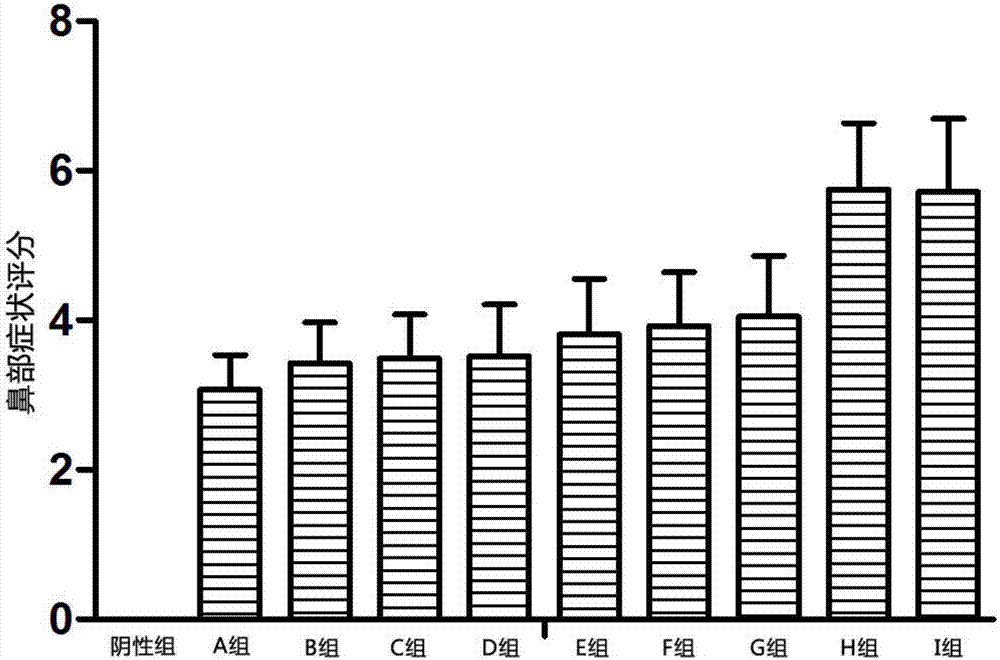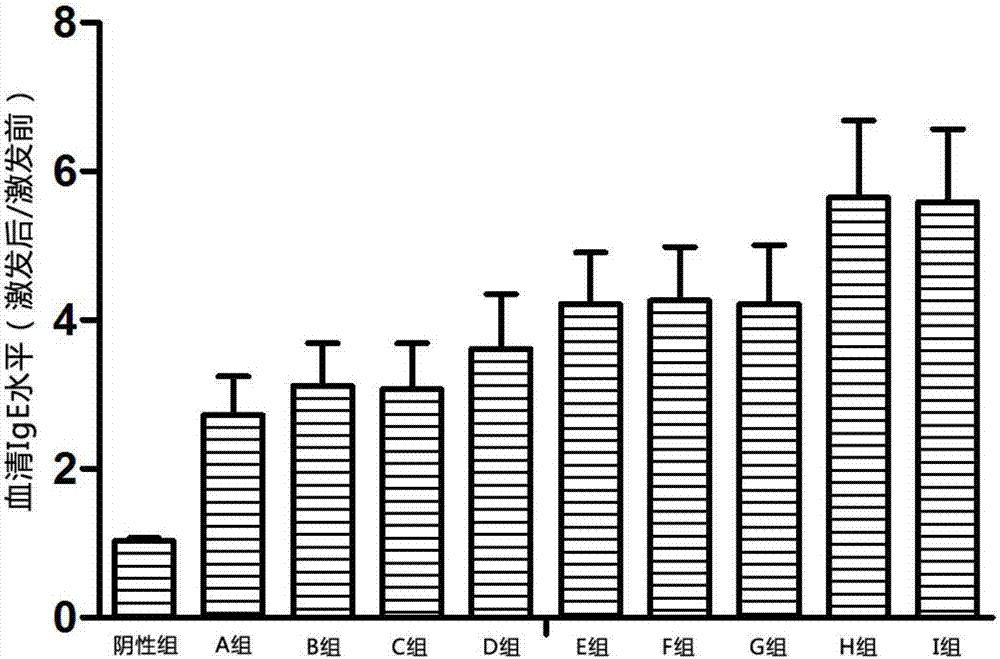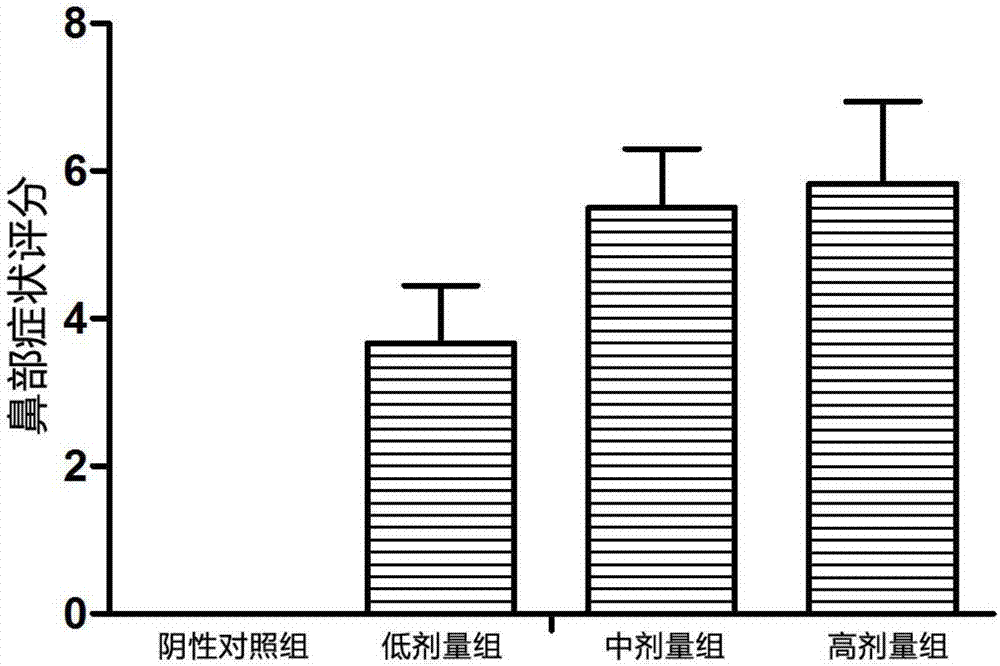Allergic rhinitis animal model construction method
A technology for allergic rhinitis and animal models, which can be used in pharmaceutical formulations, compound screening/testing, preparations for in vivo experiments, etc. It can solve the problems of non-uniformity, great differences in optimal conditions for sensitization and stimulation, and achieve Low cost, reduced allergen usage, and waste-free effects
- Summary
- Abstract
- Description
- Claims
- Application Information
AI Technical Summary
Problems solved by technology
Method used
Image
Examples
Embodiment 1
[0033] 1. Experimental animals: BALB / c mice, SPF grade, half male and half male, weighing 16-20 g, 5-6 weeks old, provided by Changzhou Cavens Experimental Animal Co., Ltd. The ambient temperature is 22-26°C, and the humidity is 40%-70%. 12 hours of alternating light, free access to food and water. SPF grade full-price granular mouse food was provided by Jiangsu Synergy Pharmaceutical Bioengineering Co., Ltd.
[0034] 2. Allergen: natural house dust mite allergen protein extract, item number: LG-5449, provided by LSL Corporation.
[0035] 3. Sensitization and stimulation
[0036] The times of sensitization were optimized according to the nasal symptom score of the mice after challenge and the IgE content in serum.
[0037] 3.1 Grouping of animals: 120 BALB / c mice were randomly divided into 10 groups according to body weight, with 12 mice in each group, which were negative control group, group A (2 sensitization, the excitation dose was 1 times the sensitization dose), Grou...
Embodiment 2
[0052] 1. Experimental plan
[0053] 1.1 Animal grouping: 48 BALB / c mice were randomly divided into 4 groups according to body weight, 12 in each group, respectively negative control group, low-dose natural house dust mite allergen protein extract group, middle-dose natural house dust mite The mite allergen protein extract group and the high-dose natural house dust mite allergen protein extract group were subjected to experiments after adaptive feeding for 5 days.
[0054] 1.2 Preparation of sensitization solution: Weigh the natural house dust mite allergen protein extract powder according to the dosage requirements of each group, dissolve it in PBS, and add a certain amount of Al(OH) 3 Adjuvant, and finally with PBS to make up Al(OH) 3 A sensitization solution with a content of 1% (mass percentage) and a natural house dust mite allergen protein extract concentration of 125 μg / mL, 375 μg / mL, and 1125 μg / mL.
[0055] Preparation of the excitation solution: Weigh the natural h...
Embodiment 3
[0070] 1. Experimental plan
[0071] 1.1 Grouping of animals: 20 female BALB / c mice were divided into 2 groups according to the weight-stratified random number table method, 10 in each group, respectively negative control group, dust mite allergen protein extract group, and adaptive feeding Experiments were performed 5 days later.
[0072] 1.2 Preparation of the sensitization solution: Weigh the natural D. farinae allergen protein extract powder according to the dosage requirements of each group, dissolve it in PBS, and add a certain amount of Al(OH) 3 Adjuvant, finally dilute to volume with PBS (Al(OH) 3 content of 1%), prepared into a natural D. farinae allergen protein extract concentration of 100 μg / mL sensitization solution.
[0073] Preparation of the excitation solution: Weigh the natural D. farinae allergen protein extract powder according to the dose requirements of each group, dissolve it in PBS, and finally make up the volume with PBS to prepare the natural D. far...
PUM
 Login to View More
Login to View More Abstract
Description
Claims
Application Information
 Login to View More
Login to View More - R&D
- Intellectual Property
- Life Sciences
- Materials
- Tech Scout
- Unparalleled Data Quality
- Higher Quality Content
- 60% Fewer Hallucinations
Browse by: Latest US Patents, China's latest patents, Technical Efficacy Thesaurus, Application Domain, Technology Topic, Popular Technical Reports.
© 2025 PatSnap. All rights reserved.Legal|Privacy policy|Modern Slavery Act Transparency Statement|Sitemap|About US| Contact US: help@patsnap.com



